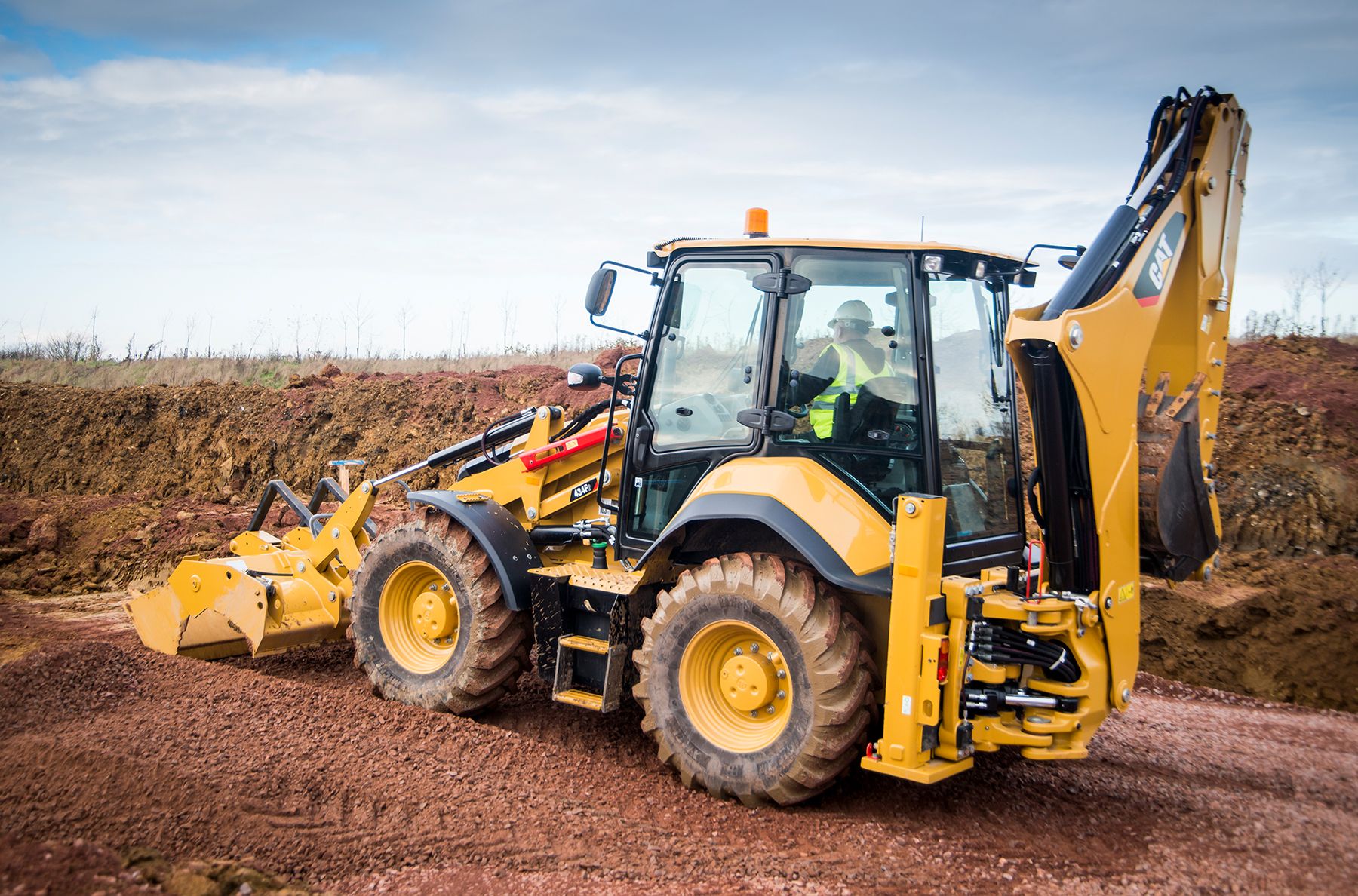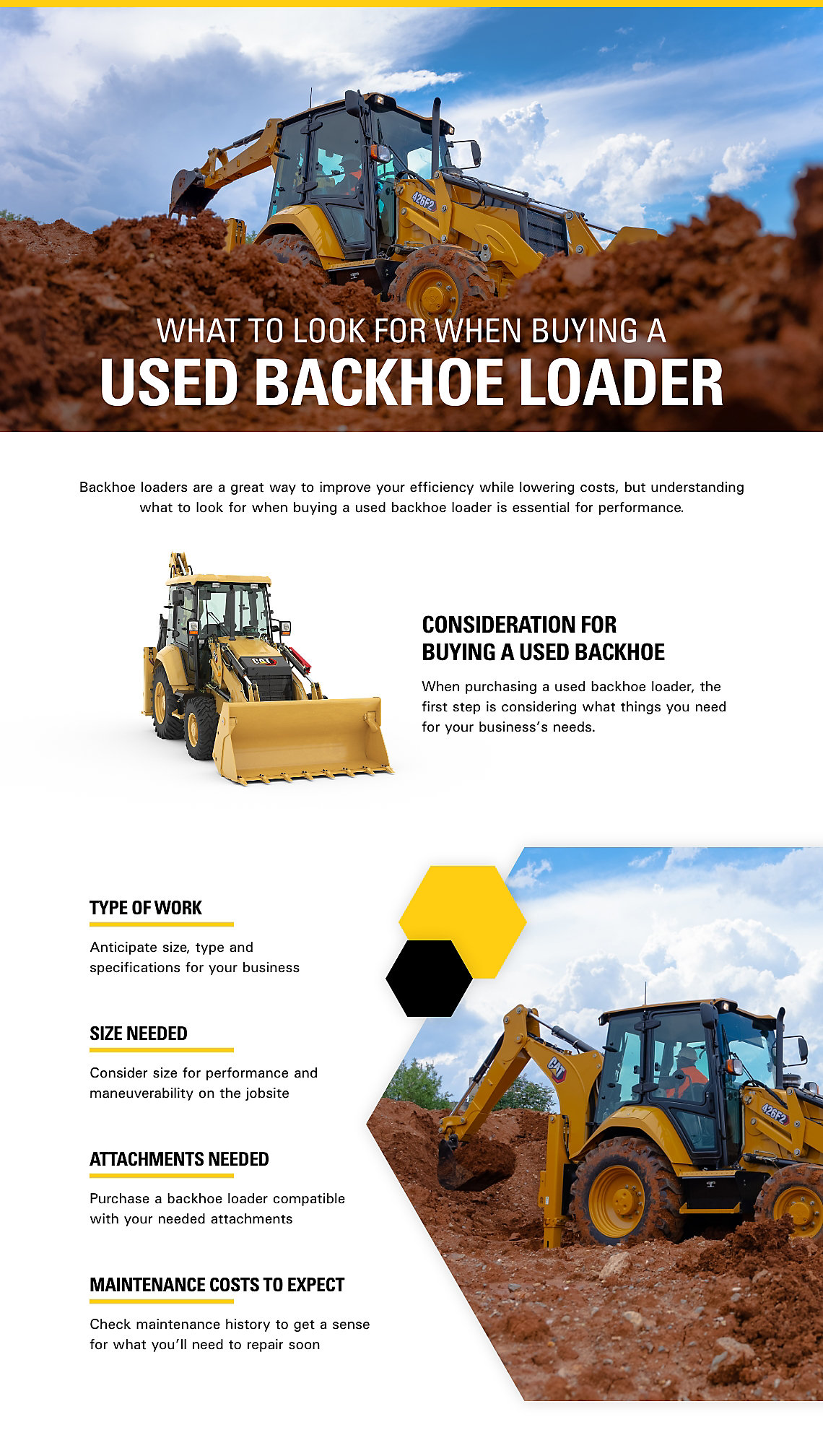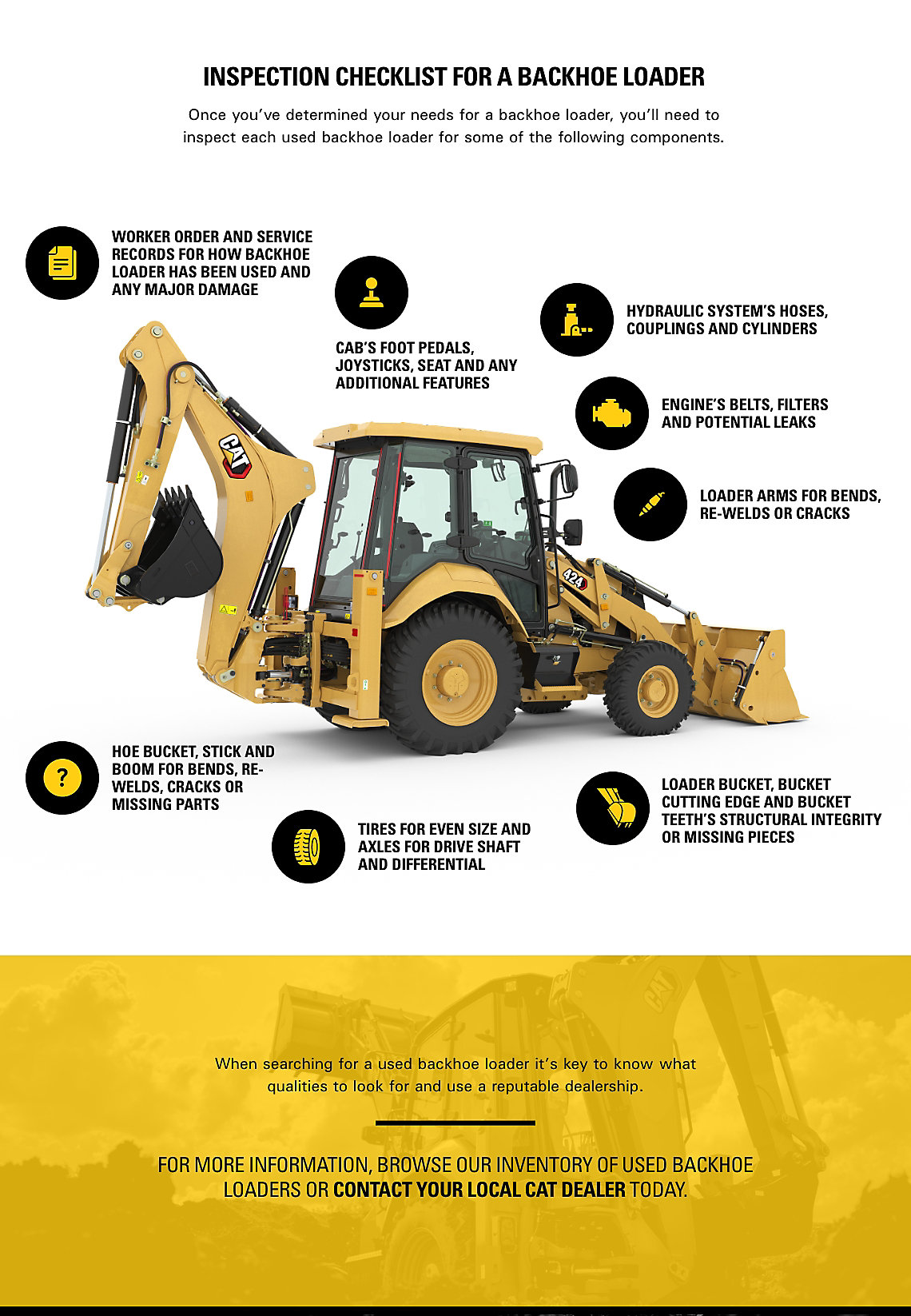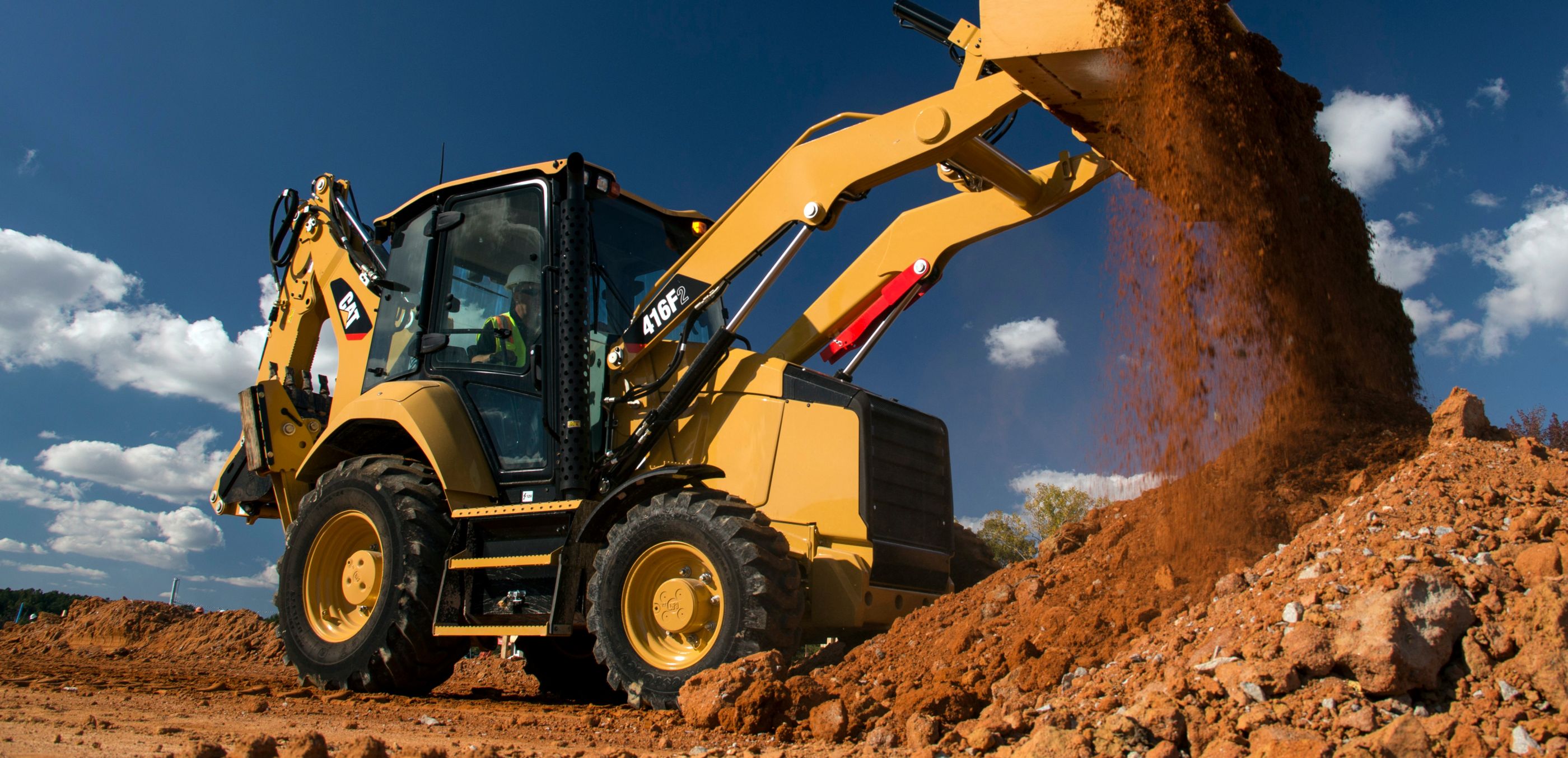

Sign In
Welcome! Sign In to personalize your Cat.com experience
If you already have an existing account with another Cat App, you can use the same account to sign in here
Register Now
One Account. All of Cat.
Your Caterpillar account is the single account you use to log in to select services and applications we offer. Shop for parts and machines online, manage your fleet, go mobile, and more.
Account Information
Site Settings
Security
Author: Small Business Expert | September 18, 2020 | Topic: Used Equipment
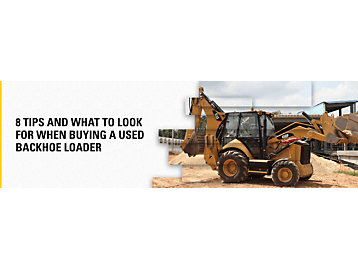
Backhoe loaders come with many advantages that make them a favorite of companies looking to improve their capabilities at a lower cost. Take a moment to review this used backhoe loader buying guide before making a purchase. You'll learn more about the advantages of investing in used backhoe loaders and find out how you can find equipment with all the qualities and performance you're looking for.
Advantages of Purchasing a Used Backhoe Loader
Buying a used backhoe loader can be a great financial decision for your company. For instance, by purchasing it at a lower initial cost, you can maintain greater cash flow. Besides the economic advantage of buying a used backhoe, you also may have a greater number of choices.
As you consider purchasing backhoe loaders, take a moment to learn about the advantage of buying one:
- Slower depreciation: Used backhoe loaders will often have been on the market for some time and will likely have gone through their most rapid depreciation period. After a backhoe's first year, its depreciation slows much more. Buying a used backhoe shields you from steep depreciation and keeps your machinery from losing its value quickly.
- Lower capital investment: Used equipment often comes at a relatively low cost. Since you don't have to put down as much to purchase the backhoe, you save money.
- More options: The used backhoe market has a wide variety of backhoe loaders to choose from. There are many different generations, sizes and model years to select and use at your work site. With all the variety, you can purchase a backhoe loader with the power and features you require.
- Additional cash flow: With the lower costs of purchasing a backhoe, you keep more cash available for other purposes that help you retain staff and grow your business.
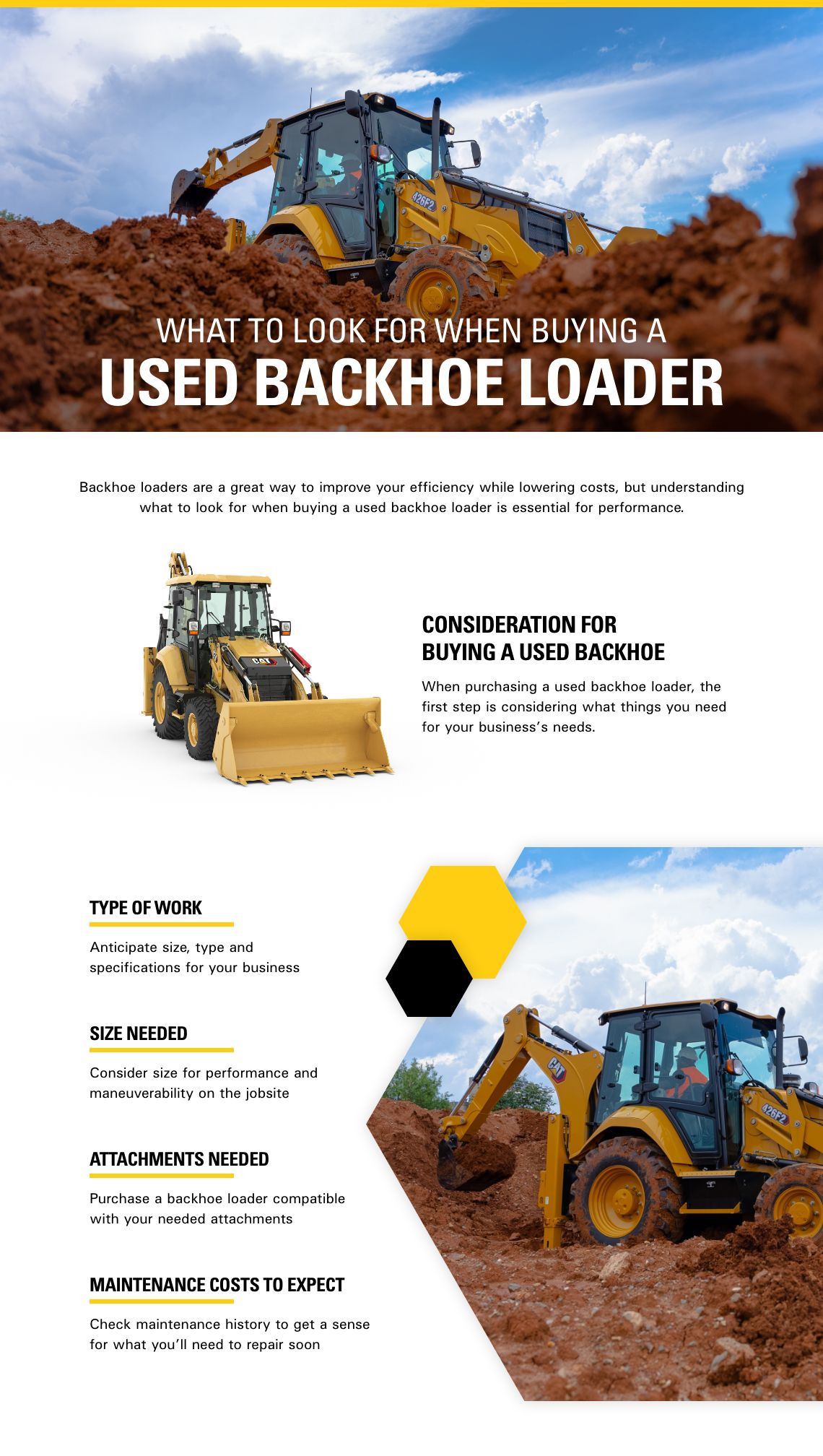
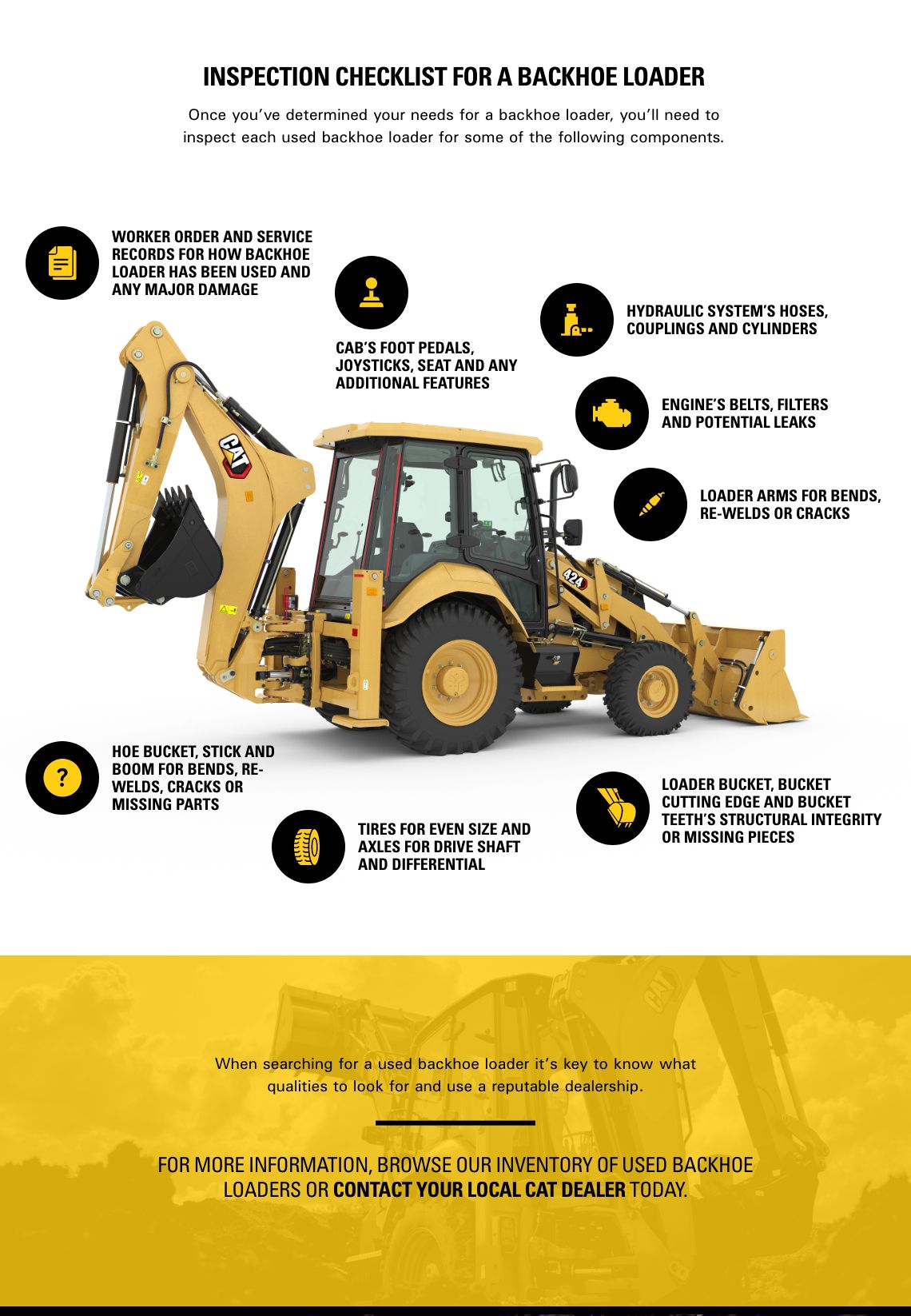
Questions to Ask Before Buying a Used Backhoe
You should make sure you go into the used backhoe loader buying process fully informed. Below are some of the top questions to ask yourself before you begin shopping:
1. What Kind of Work Will You Use the Backhoe Loader For?
One of the biggest used backhoe inspection tips you can follow is to make sure you know the kinds of jobs you're hoping to complete with the machine. By understanding the projects you plan to use the backhoe for, you can better anticipate the size, type and exact specifications of backhoe loader you need.
2. What Size Fits Your Needs?
The size of your backhoe loader is one of its most important qualities. Its size will directly affect its performance and maneuverability. If your company regularly works in tighter areas, you'll need a more compact backhoe loader that can easily turn to navigate the work site. A smaller backhoe loader isn't usually the best choice for larger areas, since it may not have the digging capacity or power to finish jobs efficiently.
Larger backhoe loaders are more suited for jobs where you need extra power and the ability to quickly cover more ground. They'll typically have larger buckets on them, meaning you can complete jobs faster.
3. What Backhoe Attachments Will You Need?
By considering the attachments available for a backhoe, you set your company up for greater success on a work site. Backhoe loaders can come with many different attachments to aid versatility. You can often find attachments like grapples, front forks, digging buckets, cold planers and concrete saws. Purchase a backhoe loader compatible with the attachments you'll need.
4. What Backhoe Loader Maintenance Costs Should You Expect?
One of the things to look for when buying a used backhoe is its potential maintenance costs. When purchasing a used backhoe loader, you should check its maintenance history. This information will let you know what's been fixed in the past and give you a sense of what you'll need to repair soon. It can also let you know if there's any current damage you'd have to fix if you purchased the equipment.
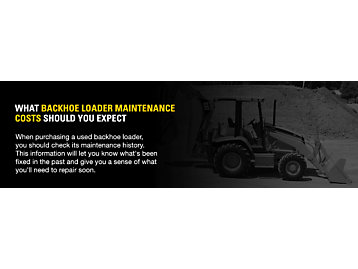
8 Inspection Tips for Buying a Used Backhoe Loader
One of the most crucial inspection tips for used backhoes is to understand which parts of the machine to check before making a purchase. You have to make sure everything is running well and that you won't end up having to pay for extra repair work after buying the backhoe. By conducting an in-depth inspection of a used backhoe loader, you can ensure you're getting a backhoe in good condition.
Review the things to check before buying a used backhoe below:
1. Hydraulic System
A backhoe's hydraulic system is crucial for the machine's moving parts. A damaged system can cause these parts not to work entirely or operate at a less efficient pace. To ensure the backhoe works efficiently, you need to inspect the various hydraulic parts.
Begin by looking at the hoses, searching for any scratches or breaks while also ensuring the couplings are in prime condition. After checking couplings and hoses, look for cylinders that are leaking or damaged, as dents or scratches are indicators something could be wrong. Damage like dents and scratches can also open your hydraulic system to contaminants.
2. Engine
After checking the hydraulic system, inspect the engine, which should be located close by. Check for loose belts, out-of-date filters and obvious leaks. You can check a filter's status by looking at the last service date on the machine's notes.
3. Loader Bucket, Bucket Cutting Edge and Bucket Teeth
A backhoe's loader bucket is an essential piece of the machine. Make sure it's in good condition by observing the bucket and looking for signs of damage. As you search for wear, examine the bucket side panels' thickness, the bottom's condition, the structural integrity of bucket welds and the state of the leading edges.
You should also see if the bucket teeth have any missing bolts or missing, worn or loose teeth. Next, inspect the bucket's cutting edge for signs of damage, such as scalloping. If you notice that the bucket's cutting edge is worn down, you can often flip it to keep it working.
4. Loader Arms
Once you've checked the bucket, you should also inspect the loader arms the bucket attaches to. Examine the arms for bends, re-welds and cracks. If you notice re-welds, you'll know that some repair work has been done. This should be a sign you need to review the workmanship and see if it was done by a professional. Bends will indicate that the machine was likely rolled, and cracks are often a sign of the backhoe loader being pushed beyond its capacity.
5. Cab
To make sure your operator will have acceptable conditions while driving the backhoe loader, examine the cab. Look over the foot pedals, joysticks and seat. Next, check for any additional pieces of technology or features. While in the cab, look for an hour meter reading to see if the wear is appropriate for how long the backhoe has been used.
You should also be given a chance to operate the backhoe loader to see if it runs well. Start the machine and put it through some standard operating tasks. After starting the backhoe, use the attachments and drive the backhoe, paying close attention. If you notice that it's hard to steer, the operating attachments lose pressure, there's a chattering noise or a high fluid temperature, it's likely the hydraulic system is damaged.
6. Tires and Axles
You can usually find loader backhoes with three kinds of axle configurations: 4x2, 4x4 or 4x4x4. Verify the equipment's configuration by inspecting the tire size and checking if the front axle has a drive shaft and differential. You can also verify the axle configuration with the machine's manufacturer. As you examine the axles, look for any signs of leakage.
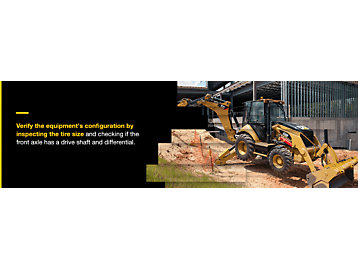
For the tire inspection, see if there are any size differences between them. You should check if the rims have any cracks, as they could cause an issue when you attempt to change out a tire. Review the tread depth using a tread depth gauge, and inspect the lug nuts, ensuring they aren't loose.
Next, take a look at the driveshaft and search for any damage caused by rough terrain or rocks. While underneath the backhoe loader, see if there are any leaks. Once you start the vehicle, listen for the drive shaft making extra noise. If there's excess noise, it could be a sign the universal joints or transmission need replacing.
7. Hoe Bucket, Stick and Boom
Check the backhoe's stick and boom for any bends, re-welds or cracks. Like with the loader arm, re-welds are a sign of repair, and cracks are indicative of the backhoe having been pushed past its capacity. Bends will reveal that it's likely the backhoe has rolled.
After inspecting the boom and stick, move on to look at the hoe bucket. To verify that the hoe bucket is in good condition, see if there are any missing bolts or teeth. You should also ensure the backhoe's dig depth goes as far as you require.
8. Work Orders and Service Records
Besides doing a physical inspection of the parts, get more knowledge about the backhoe loader by reviewing its various documentation. Work orders and service records will tell you more about how the backhoe loader has been used and if there's been any major damage.
Who Should You Purchase a Used Backhoe From?
When you purchase a backhoe loader from Cat Used, you can expect high-quality, reliable machines. Cat® dealerships offer a vast inventory of used construction equipment and friendly dealer service. Find out more about why many companies turn to Cat Used for used backhoe loaders:
- Helpful dealer support: Your Cat dealer will be happy to walk you through the buying process and help you find a backhoe loader most suited to your requirements. After you purchase a backhoe, your dealer's service doesn't stop there. You'll always have a team of experts ready to review any questions you may have about your machine or help with maintenance issues.
- Many financing options: Cat dealerships know companies have a variety of budget priorities, and they want to help you get a backhoe with financing that works for you. Cat dealerships provide several financing options, customized to your company's budget. Your dealership can also offer an Equipment Protection Plan if needed.
- More backhoe loader equipment from the Cat dealer network: An advantage of working with Cat Used is that you can select equipment from the huge network of Cat dealerships. This network houses thousands of Cat machines, as well as tons of parts. With all the options you can find through the network, you can purchase a backhoe loader with the power and features you require.
- Long-term value and reliability: Cat equipment is known for its reliability and exceptional performance. Cat backhoe loaders are designed to last a long time, meaning you can expect their value to hold longer than other competing brands. If you decide to sell one, you can recoup a portion of your original investment.
- Detailed maintenance and service records usually available: Cat dealerships know how important it is for companies to be aware of their equipment's history. All Cat dealerships attempt to get detailed maintenance and service records from most used backhoe loader they buy. These records give you the ability to make an informed decision.

Purchase Your Next Backhoe Loader From Cat Used
When you're in the market for a used backhoe loader, turn to Cat Used. We connect you to the wide network of Cat dealerships all around the world. Cat dealerships offer backhoe loaders in various sizes, price points, ages and hour ranges to help you find equipment that fits your needs.
Browse our inventory of used backhoe loaders today. If you'd like more information, find and contact a Cat dealer in your area. When a piece of equipment isn't available, you can sign up for email alerts to be notified when it's available for purchase.
